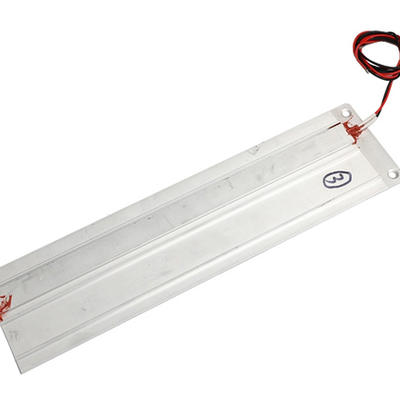Anti-corrosion self-control sampling tube series 24V
1. Product introduction of Corrosion-Resistant Heat Tracing Sampling Composite Pipe
Corrosion-resistant sampling composite pipe with heat tracing is a vital component in environmental monitoring system. It consists of a group of corrosion-resistant and high-performance resin conduits, supplemented by self-limiting heat tracing (constant power tracing) and compensation cables, plus insulation layer and flame-retardant polyethylene (PE) protective jacket. The self-temperature-limiting tracing belt has the function of automatic temperature limitation, which can ensure the constant temperature in the sampling tube, so as to keep the collected samples consistent with the initial values as much as possible, thus ensuring that the environmental monitoring system can continuously and accurately collect gas samples. According to the actual situation of gas sample composition and temperature, the conduit of corrosion-resistant and heat-tracing sampling composite pipe can be made of different materials, such as PFA, FEP, PVDF, PE and nylon 610. The medium, low and high temperature heat tracing belts can be selected, and compensation wires and power cords can be added according to users' needs. This product was listed as a national key new product promotion plan in 2002, and applied for a national patent in 2001. Our company is currently one of the professional manufacturers of such sampling tubes.
Corrosion-resistant and heat-tracing sampling composite pipe is a complex composed of many devices, and several systems are combined on a limited section.
● Sampling system: sampling tubes of various types and materials can be combined: Teflon PFA, FEP, nylon 610, copper tube, 316SS, 304SS, etc.
● Thermal system: efficient thermal insulation, flame retardant and lightweight insulation layer; Automatic temperature limiting heat tracing cable or constant power heat tracing cable.
● Electrical system: instrument signal cable, compensation cable and control cable can be equipped to meet the needs of instrument display and monitoring.
● Safety system: The corrosion-resistant heat tracing sampling composite pipe can adapt to various technological conditions, and it is shielded and isolated by aluminum foil or wire mesh to achieve the effects of fire safety, anti-static and electromagnetic shielding. Some pipes are also attached with waterproof membrane and sheath to enhance flame retardant and ultraviolet protection. This multifunctional composite pipe system combination simplifies the complex engineering process. It provides a good guarantee for remote work and system remote diagnosis. The heat tracing system makes the gas in the pipe not condense and measure above the dew point, so it can ensure the measurement accuracy and provide conditions for the computerization of central centralized control. The reinforced outer sheath can prevent cross infection and damage caused by other factors.

2. Corrosion-resistant heated sampling composite tube: Basic structure, classification, and model
2.1 Basic structure
1- Outer protective sheath
2- Insulation layer
3- Sampling tube D1
4- Power cord
5- Heating cable
6- Sampling tube D2
7- Core
8- Shielding reflective film
9- Compensation cable
2.2 Classification
2.2.1 Based on the type of heating cable:
a) Self-regulating heating composite tube;
b) Constant power heating composite tube.
2.2.2 Based on different sampling tube materials:
a) Polyvinylidene fluoride (PVDF) composite tube;
b) Perfluoroalkoxy (PFA) composite tube;
c) Soluble polytetrafluoroethylene (PTFE) composite tube;
d) Polytetrafluoroethylene (ivory PTFE) composite tube;
e) Stainless steel (0Cr17Ni12Mo2) composite tube.
2.3 Model
2.3.1 The model coding of composite tube products should include at least the following information:
a) Nominal outer diameter, in millimeters (mm);
b) Sampling tube outer diameter, in millimeters (mm);
c) Number of sampling tubes;
d) Sampling tube material;
e) Operating temperature (℃);
f) Type of heating cable, including self-regulating heating and constant power heating.
3. Composite Tube Model Representation:
Introduction to Typical Models
Example 1: Model FHG36-8-b-120-Z represents a nominal outer diameter of 36 millimeters, a sampling tube outer diameter of 8 millimeters, a quantity of 1, a material of fluorinated ethylene propylene (FEP), a working temperature of 120℃ inside the sampling tube, and a self-regulating heating composite cable.
Example 2: Model FHG42-10(2)-c-180-H represents a nominal outer diameter of 42 millimeters, a sampling tube outer diameter of 10 millimeters, a quantity of 2, a material of soluble polytetrafluoroethylene (PFA), a working temperature of 180℃ inside the sampling tube, and a constant power heating composite cable.
Example 3: Model FHG42-8-6(2)-c-200-H represents a nominal outer diameter of 42 millimeters, a sampling tube outer diameter of 8 millimeters for d1, a quantity of 6 millimeters for d2, a material of soluble polytetrafluoroethylene (PFA), a working temperature of 200℃ inside the sampling tube, and a constant power heating composite cable.
Example 4: Model FHG45-8(2)-6(2)-f-250-H represents a nominal outer diameter of 45 millimeters, a sampling tube outer diameter of 8 millimeters for d1 with a quantity of 2, a sampling tube outer diameter of 6 millimeters for d2 with a quantity of 2, a material of stainless steel (0Cr17Ni12Mo2), a working temperature of 250℃ inside the sampling tube, and with heating.
self-control sampling tube series 24V



































































































































